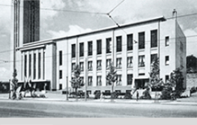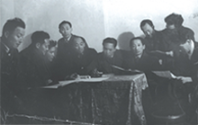INTRODUCTION
History
- INTRODUCTION
- History
HISTORY
The Birth of the NTOK
The National Theater of Korea located on Namsan, which is a central of the metropolitan city of Seoul founded in April 1950. It was not until the National Theater established on Namsan in 1973 that it was transferred from place to place under many circumstances. After the Korean Government was established in 1948, an executive order to establish a national theater was promulgated. The Bumingwan, the City Hall(now Seoul Metropolitan Council) was designated as a site for a national theater, and Yoo Chi-jin was named the first president of the National Theater of Korea. The New Theatre Council was inaugurated with a national theater in January 1950, under which two resident drama companies, Shin-hyup and Geuk-hyup. They staged Wonsulrang(written by Yoo Chi-jin) for the opening performance in April 1950. It drew more than fifty thousand visitors for 15 days. The subsequent staging of a Thunderstorm(written by Cho Woo) was successful in a row. The play drew approximately 75,000 people, or about one sixth of the total population of Seoul and registered a new high in Korea's drama history. While it was working on its third performance, all activities of theater were totally paralyzed with the outbreak of the Korean War only after 57 days of opening.


During the Korean War
The war made the theater's functions completely paralyzed. Many artists were either kidnapped or defected to the North Korea. Consequently, hopes for a new theatrical art were dashed. However their passion survived the internecine war. A money bill to rebuild the National Theater was passed in May 1952 by the National Assembly and the cabinet meeting. With a decision to use the Daegu Cultural Center as a new place for the National Theater, it reopened in a refuge of Daegu.

Return to Seoul
Returning to the capital after the war, the National Theater opened at the Sigonggwan(Seoul Public Hall) in June 1957 on condition that it would occupy part of the latter. With no resident companies under exclusive contract with the National Theater, it invited members of Shin-hyup to work for the National Drama Company. Witnessing ordeals such as the April 19 Student Uprising and the May 16 Military Coup on one hand, and a rapid influx of visual media into Korea including the film industry on the other, the theatrical arts faced new challenglishes. Rising up to such challenglishes of the times, the National Theater came up with a variety of self-help measures including 'Opening a Prize List of Plays' which aims at boosting performances of original plays. With the newly establishment of Seoul Public Hall by the Seoul City Government, Sigonggwan became an exclusive building for the National Theater in Myeongdong. Timing with the Opening ceremony of the renovated National Theater in March 1962, the theater inaugurated resident companies including the National Dance, Changgeuk, Opera Company in addition to the existing Drama Company.

Foundation of Myeongdong National Theater and Resident Companies
Having been using Sigonggwan together with the city of Seoul, the National Theater of Korea started using the venue exclusively after Seoul Citizens Center opened in November 1961. Total construction expenses of about 180 million Hwan were used to perform a full-scale remodeling of the interior before holding an opening ceremony of the Myeongdong National Theater in March 1962. Through this remodeling, the total number of seats was reduced from more than 1,000 to only 800 while expanding the stage by more than 1/3 to set up a new orchestra box. By additionally installing a rotating stage, automatic lighting, etc., it was finally shaped into an arts theater. In time for the opening ceremony, two theater companies, Sinhyeop and Mingeuk which had been the theater’s resident companies, were restructured to become the , and National Gukgeuk Company, National Dance Company of Korea and National Opera Company of Korea were newly founded. Also in 1969, the National Theater took over the operating rights of “KBS Symphony Orchestra” to satisfy the need for a nation-leading symphony orchestra. Constituted of 3 families and 90 members, “KBS Symphony Orchestra” was renamed to , serving as a resident company. Having failed to fulfill its functions as a production theater for some time despite owning a nation-leading traditional performing arts resident company, the National Theater of Korea took on a big challenge in September 2012 when it introduced “National Theater Repertory Season” in which performances of resident companies fill the stage and lineups and tickets for such performances are made public in advance. Since the introduction, the National Theater of Korea achieved remarkable results in quality and quantity of performances, including the number of performances by resident companies, number of audience members, and ticket sales.

The Ntok in Namsan
Returning to the capital after the war, the National Theater opened at the Sigonggwan(Seoul Public Hall) in June 1957 on condition that it would occupy part of the latter. With no resident companies under exclusive contract with the National Theater, it invited members of Shin-hyup to work for the National Drama Company. Witnessing ordeals such as the April 19 Student Uprising and the May 16 Military Coup on one hand, and a rapid influx of visual media into Korea including the film industry on the other, the theatrical arts faced new challenglishes. Rising up to such challenglishes of the times, the National Theatercame up with a variety of self-help measures including 'Opening a Prize List of Plays' which aims at boosting performances of original plays. With the newly establishment of Seoul Public Hall by the Seoul City Government, Sigonggwan became an exclusive building for the National Theater in Myongdong. Timing with the Opening ceremony of the renovated National Theater in March 1962, the theater inaugurated resident companies including the National Dance, Changgeuk, Opera Company in addition to the existing Drama Company.











